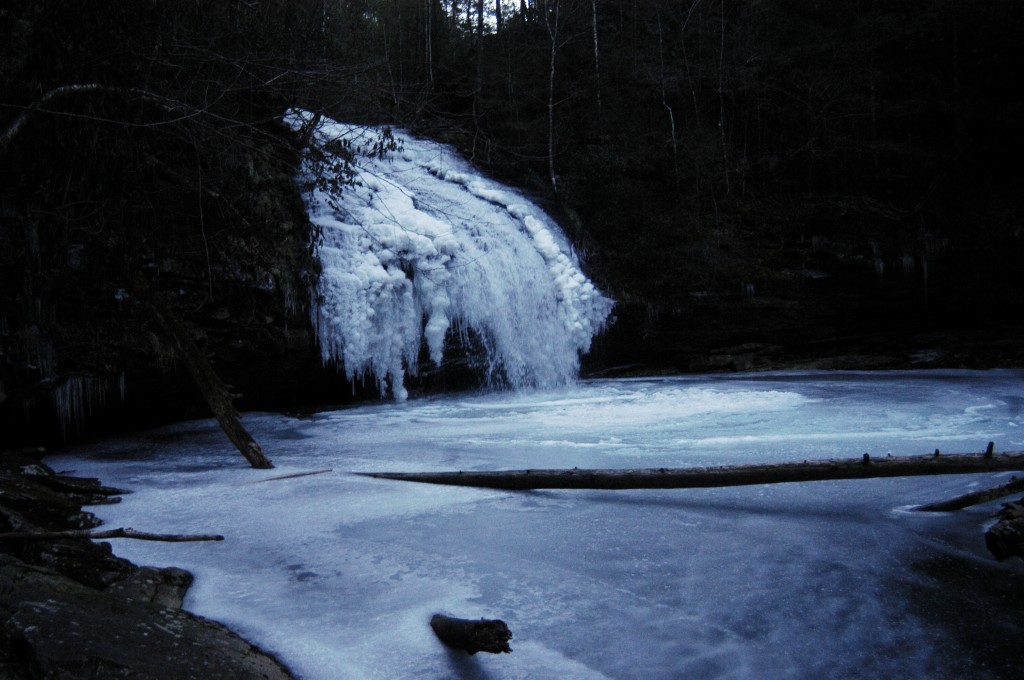
By Will Jones
Staff Writer
It had been well below freezing for six days with no precipitation, rain or snow. When it is this cold and dry for this long, the groundwater freezes and the narrow creeks and branches it feeds become too sluggish to push around or through the ice which forms along them. A swift or deep stream will not usually freeze completely, but the shallow ones that run down every gnarl and wrinkle of the Cumberland Mountains will slow to barely a trickle, running unseen beneath the ice. The spilling cataracts and cascades ice into bright and jagged shapes, and waterfalls will freeze.
The falls at Stinging Fork have been my favorite for a long time. The narrow Shut-In Gap Road splits off of Highway 68 West early and follows the tumbling Piney River before winding precariously up Walden’s Ridge. The route is barely paved—at one time it was an old logging route that serviced a number of now overgrown Bowater Paper Company pine stands along Newby Branch. Most of the pines were killed in the late 1990s by pine beetles, and Bowater ceded the now worthless land to the state for a nominal fee and tax write-off.
The road cuts past a few small farms, a rather dubious saloon called The Blistered Chicken, and acres of empty clear-cuts slowly turning back to wilderness. The stubbiness of these new growths open up the land at the top of the plateau, and every ridge and knob for miles round is visible against the horizon.
I reach the Stinging Fork parking lot, trailing a thick cloud of dust that hangs behind me listlessly in the still and bitterly cold air. I want to get to the falls before dark, take my pictures, and leave. I do not want to turn my ankle on an icy stone, fall in the water, or spend any more time than I have to in the dark. I know the area very well, well enough to know that the trails are often steep and poorly marked, and that the locals can occasionally be curious. The last thing I want to do is stay the night out here.
So, I set off down the trail on a brisk jog, my steps crunching in the frozen mud past glittering deer and raccoon prints, and those of other hikers (Chacos and Carhartts stamped into the mud; someone has been going either barefoot or in Vibrams—both seem about equally unpleasant in this kind of cold.)
Like most of the land out here, Stinging Fork Natural Area used to be a part of Bowater, and the trail begins in short new-growth forests—thickets of upstart cedar and sumac saplings braid between the dignified, skeletal rows of dead loblolly pine. The trail is wide and the sky very bright and open; this forest is young and few trees are taller than twenty feet or so—none high enough to obscure my view of the sky. But as the trail descends into the gorge, the trees grow taller, older, darker. Too steep and hardy to clear out, the old growth of oaks and elms were left almost entirely alone by loggers. Entering them I am left with the distinct impression of walking into a cage, the stark and snarling outlines of the branches snapping shut above me as I enter.
There is a single magnolia on the lip of the gorge, and a handful of scraggly cedars—everything else is gray and leafless. Though I was close, I could not hear the water, which was a good sign: it had been a hard freeze. The trail was in some places completely sheathed in ice five or six inches thick, and I reeled drunkenly about from stone to stone, grasping at nearby rocks and tree limbs to steady myself, my camera swinging precariously from my neck. It felt a bit like a trip to the skating rink, only here there was no Bon Jovi to drown my screams.
The rocks are slickest at the very base of the falls, where the mist has stuck and frozen into a kind of Teflon coating over stone and bank. But the ice over the falls was stunning.
Stinging Fork Falls drops 30 feet or so into a deep pool, and the mantle hides a small grotto inaccessible to all but swimmers. In the summertime, kayakers like to run the falls, which is officially a Class V when the water is high. At the base a thousand broken logs encircle the plunge pool, testifying to the power of the branch when the late summer rains feed it.
But now everything is still and sharp. The falls had frozen fastest on the edges of the mantle where the flow had been slowest, and the resulting icicles hang sharp and savage in the dwindling light. The center of the falls had frozen slowly into layers—the ice mounded into thick muscular clots, twisted along the back of the falls like the knots on an old oak.
I shivered for a few minutes, snapped a few shaky pictures, and managed to fall deep enough to soak my legs up to mid thigh. Then I climbed out of the gorge and back onto the trail.
I waddled back in the dark, the frozen legs of my jeans knocking woodenly against each other. Somewhere off to the side of the trail, a frightened deer sprang away in a series of distant and invisible crashes and then all was still.
So much of nature seems so quiet, even passive. We return to the same places years later and find them exactly how we had left them, barely a branch or stone stirred. But a waterfall gashes rock, sweeps away tree branches and careless swimmers, tosses into the air great clouds of glittering steam—and makes so much noise doing it that we cannot help but build trails through old tree farms and steep gorges so that we too can sit and watch.
It is surreal then to see one so still, to see so much noise and motion and potential energy frozen to silver against the black stones. In three months, the entire gorge will practically glow green and the falls will roar and chomp and wave great moss-smelling clouds of incense into the warm and buzzing air. In six months, there will be mosquitoes and horseflies and thousands of crayfish scuttling backwards beneath stones, and old people will come out wearing visors, and families with dogs will pile out of Suburbans to pick blackberries. But the winter makes us wait.


